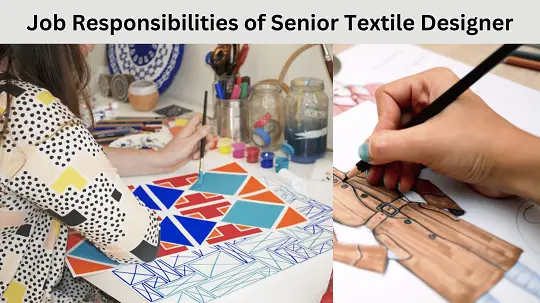Job Responsibilities of Senior Textile Designer
A textile designer does design, research, product development, and other activities in the textile industry. It is implementing concept to design. In this article, we explain the Job Responsibilities of a Senior Textile Designer in the textile industry.

Job Responsibilities of Senior Textile Designer
- Conceptualization and Innovation:
- Conceptualize and create innovative concepts, styles, designs, and products that align with current trends and the brand’s aesthetic.
- Generate fresh ideas and design directions, pushing creative boundaries while maintaining brand identity.
- Product Development:
- Translate conceptual designs into tangible products, making decisions on design elements such as colour, pattern, and placement.
- Ensure alignment with brand guidelines and quality standards throughout the development process.
- Research and Exploration:
- Conduct research to explore new techniques, materials, stitches, and patterns, enriching the in-house design library.
- Stay updated on emerging trends and innovations in textile design, incorporating relevant findings into design concepts.
- Collaboration and Execution:
- Collaborate with karigars (artisans) and utilize provided resources to effectively execute designs, ensuring high-quality craftsmanship.
- Foster strong relationships with production teams to facilitate smooth communication and workflow.
- Presentation and Communication:
- Develop mood boards and trend boards for internal use and exhibitions, effectively communicating design concepts and inspirations.
- Translate pre-approved concepts into finished products, presenting samples for review and feedback.
Textile Designer Education Requirements, Experience, and Skill Requirments
- Bachelor’s OR Master’s degree in Textile Design or related field, with a minimum of 4-5 years of experience in textile design.
- Proven track record of innovation and creativity, with a strong portfolio showcasing original designs and concepts.
- Proficiency in design software such as Adobe Illustrator, Photoshop, and CAD programs.
- Excellent communication and presentation skills, with the ability to effectively convey design concepts and collaborate with cross-functional teams.
- Strong organizational and project management abilities, with a keen attention to detail and the ability to manage multiple projects simultaneously.
- Knowledge of textile production processes and techniques, with experience working directly with artisans and manufacturers.
- Passion for textiles and a commitment to staying abreast of industry trends and developments.
- Ability to thrive in a fast-paced, dynamic environment and adapt to evolving business needs.
- Experience in exhibition design and booth management is a plus.
- Join us if you are a dynamic and experienced textile designer ready to lead innovation and creativity within our design team.
Conclusion
Textile design is a discipline that combines creativity and technical understanding. If you have a passion for textiles and an eye for design, this could be an excellent career path for you. They apply their creativity and technical skills to create patterns and textures for a variety of products, including clothes, furniture, and carpets.
- You would love to read: Difference Between Fashion Designer and Technical Designer
- Functions of The Design Department in Garments Industry
- Responsibilities of A Fashion Designer in Garments Industry
Job Responsibilities of Senior Textile Designer
